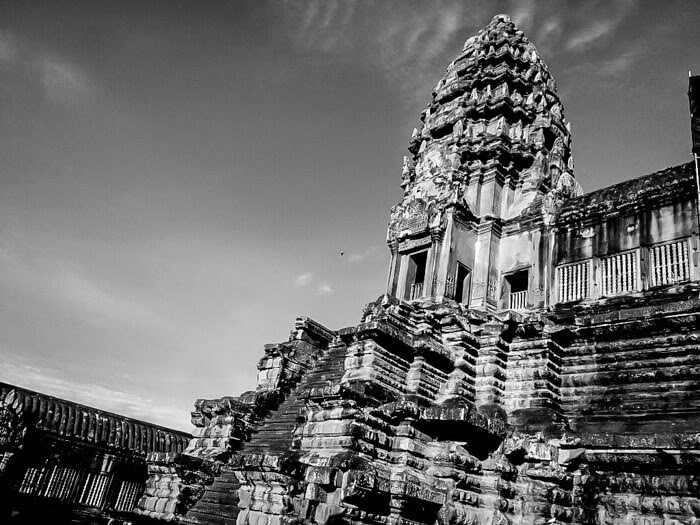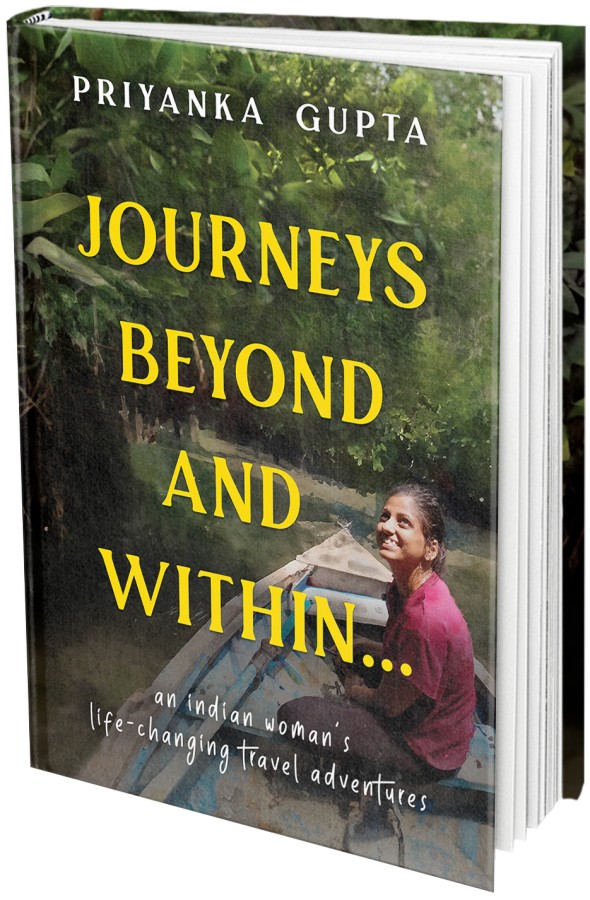My Cambodia Travel Blog on the Atrocities Unleashed on the Country
I was climbing the stairs of a high school in Phnom Penh, the capital of Cambodia. No, I did not intend to repeat high school to recognize the petals and sepals of a flower better. The school wasn’t ordinary. The faces of the men and women that had been tortured and killed in its classrooms stared at us from behind the glass frames hung on the bloodstained walls. The rusted iron bars, withering waterboards, and used bloody clothes kept in those classrooms narrated a gruesome story of the ruthless Cambodian massacre, that happened not so long ago. The metal shackles with which people were tied to the waterboards and to the iron bars were still chained to them; I assume those metal chains couldn’t be used for anything else now.
Unwillingly, I vividly imagined the bodies possessing those faces and donning those gory clothes tied to the iron rods with the cold shackles. A guard came throughout the day to beat them and torture them with electric shocks as the helpless stifled on the floor. Or to cut them with knives and suffocate them with plastic bags. Blood oozed out of the wounds of the tortured but medicine was out of the question. Four small spoonfuls of rice porridge and watery soup of leaves were given to them twice a day.
My skin crawled. I shivered in the scorching month of June.
Until only a few weeks ago, I didn’t even know about the details of the Cambodian genocide in which more than 2 Mn people were tortured and murdered by the Pot Pol headed Khmer Rouge regime in the years 1975 to 1979. And now I dragged myself around that school where each classroom felt more cold and eerie than the previous one. Maybe because I knew that innocent people had been tortured in those rooms. Or maybe because I could still see and smell their dry blood.
The huge school which served as a torture prison is now called Tuol Sleng Genocide Museum. Tuol Sleng means the hills of the poisonous trees. I trudged from its one room to another. From one floor and building to another. And then I walked out of the buildings to sit on one of the benches on the ground floor that shaded the morose visitors from the bloodshot sun. I was making myself believe that that place had once served as a playground for growing children.
Maybe I hadn’t had enough from one of the 150 execution centers because a few hours later I found myself plodding around the killing fields on the outskirts of Phnom Penh. That was the place where the almost-dead people were brought to dig their own graves into which they were thrown after being killed with a poison spade or a sharpened bamboo stick (if hunger or disease hadn’t killed them already).
I walked past by an old Chankiri tree against which the children were bashed to smash their skulls. Many red ribbons were tied to the tree now. I was one amongst the swarm of people that staggered from one brick structure enclosing bones and skulls to another while wiping their eyes and noses with their handkerchiefs and the unprepared ones with tissues. Except that I could not cry. I didn’t want to. Instead, I thought about the millions of people that had died in India during the independence and the partition and the post-independence wars.
My heart was broken; nothing poetic about it. Phnom Penh killing fields could break anyone’s heart at first sight. We had just carefully walked through mass graves so as not to step upon a bone or a skull, of an innocent killed brutally and prematurely, not long ago.
I don’t have any photo of the school or of the killing fields. I did take photos but maybe I deleted them to erase the memories of what I had seen. Maybe I cannot find the pictures, for my own good. I don’t need them anyway. I can still feel the eyes, now reduced to holes, of the skulls, preserved and displayed in the big glass stupa in the middle of the killing fields, gazing at me.
I wonder why the bones and skulls were displayed instead of being buried. But who am I to speak? I have never been killed tragically and my bones have never been put on display. Maybe, the showcasing is to warn the world of human nature. Or maybe it is to let the dead look at the world freely now, for as long as they want to.
I left Cambodia with a heavy heart. Not just because of the mass graves but because of the poverty and the people who always tried to fraud the travelers or incessantly shouted at them to sell something or to take them somewhere. I grew tired of the deceivers and their naive English vocabulary. But what else could they have done?
Apologies for such a tragic tale but my travels are never only about the sapphire-blue beaches and the golden hills. One also travels to see the wrong that has been unleashed upon the world and its people. We cannot undo what has been done. But we can at least try to understand the human nature that forced many of us to brutally torture and kill millions of other people; sometimes for power, sometimes for money, and sometimes for ego.
Mass genocides alarm us but haven’t they been happening since the earth came into existence? Many forms of primitive men and gigantic mammals and sea animals and birds are extinct now. Of course, evolution. But humans have played a major role in these extinctions to ensure their own survival. We take what we need. No matter whom we have to destroy in the process. And this is the most real and raw human nature.
So didn’t the communists of Khmer Rouge also only followed their own belief? Haven’t all powerful people and empires of the world done the same? And when one of these cruel power is called out, some other power, which pretends to be just, overthrows the previous one, and then does what it feels right.
Isn’t the US involved in almost every war and massacre in the world? Doesn’t the Vatican hold secret documents in some of its rooms, which if opened and read would devoid the world of its faith and religion? Don’t the Fathers, donned in the robes of religion, molest children and then are transferred somewhere else in the church? Are they better or worse than the Khmer Rouge for having scarred the nascent minds of little boys and girls forever?
Wouldn’t these children avenge the world by doing something similar or worse?
Who we are and what we do are not just a function of our personality and priorities, but also of our circumstances and our history. We can map and trace a few of our characteristics to what we have been eating at breakfast or what our mother said to us when we didn’t score well but those are the outermost layers of our onion-shells.
How did the Khmer Rouge government become what it was? Whose fault was it? Should we even find faults or just accept everything as it is? But then aren’t we cowards?
What differentiates us from Hitler or Stalin or Nero or Pol Pot or Pinochet Ugarte? Didn’t they have hearts? Were they raised badly? Why didn’t they value human life?
I don’t know if we would ever find answers to these questions. But we can at least try to create good homes for children who are the future of the world. We can be a little more empathetic to the people around us. We can fill our little worlds with love, peace, and laughter to dilute some of the hatred. We can look beyond the haggling skills, torn clothes, or fraudster tricks of the people to see who they actually are.
A little more positivity in everyone’s life wouldn’t cause any harm. Maybe, that’s what it takes to stop a boy from becoming a Hitler. Or a Pot Pol from becoming the world’s most cruel communist.
Also Read: Relearning The Most Important Principles of Life– With The Little Prince of Antoine de Saint-Exupéry
The brighter side of Cambodia was the magnificent Angkor Wat temple, the oldest and largest religious site in the world. Against the rising sun and the orange sky, the ancient temple looked majestic. And the outside of the temple was as beautiful as its inside.
You would enjoy my gorgeous photo essay of Angkor Wat: The Historic and Breathtaking Angkor Wat – Wrapped in a Photo Essay and Mystical Mythology
The Logistics
You can stay in Siem Reap, to visit Angkor Wat, and in Phnom Penh, to visit the killing fields and the museum.
Siem Reap was cheap and a hostel bed in a dorm was 4-5 USD a day. Phnom Penh is a big city and has a riverfront of Mekong and Tonlé Sap rivers. Many hostels and hotels and restaurants are located on the riverfront. Just look for a nice place with an affordable price on either Booking.com, Airbnb, or Agoda. I booked one bed in a female dorm in a hostel in the interior city as the riverfronts are always more expensive.
Travelers are Cambodia’s primary source of income, apart from agriculture. The economy is bad and one Cambodian riel is 1/4000 of a US dollar. The common currency used is USD and even the ATMs dispatch dollars. The use of US dollars makes Cambodia more expensive than its neighbors.
My experience in Cambodia was limited to Siem Reap and Phnom Penh. And I would suggest you spend a few days in both the places. Walk around. Watch out for those locals who try to trick you. You can also try to do some eco-friendly and responsible travel activities while you are in Siem Reap by following this guide.
What do you think we should do about the wrong that is happening in the world? Should we just cry and move on? Or do something else? Let me know in the comments.
*****
My much-awaited travel memoir
Journeys Beyond and Within…
is here!
In my usual self-deprecating, vivid narrative style (that you love so much, ahem), I have put out my most unusual and challenging adventures. Embarrassingly honest, witty, and introspective, the book will entertain you if not also inspire you to travel, rediscover home, and leap over the boundaries.
Grab your copy now!
Ebook, paperback, and hardcase available on Amazon worldwide. Make some ice tea and get reading 🙂
*****
*****
Want similar inspiration and ideas in your inbox? Subscribe to my free weekly newsletter "Looking Inwards"!



Priyanka Gupta, thank you for this post. Its very inspiring.
You are welcome. Glad you liked it. Please keep reading 🙂